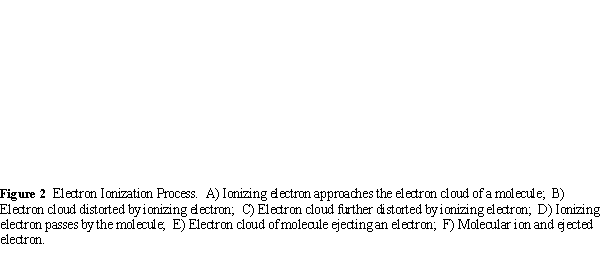
Electron Ionization. Electron Ionization (EI) is the most common ionization technique used for mass spectrometry.(1) EI works well for many gas phase molecules, but it does have some limitations. Although the mass spectra are very reproducible and are widely used for spectral libraries, EI causes extensive fragmentation so that the molecular ion is not observed for many compounds. Fragmentation is useful because it provides structural information for interpreting unknown spectra.

The electrons used for ionization are produced by passing a current through a wire filament (Figure 2). The amount of current controls the number of electrons emitted by the filament. An electric field accelerates these electrons across the source region to produce a beam of high energy electrons. When an analyte molecule passes through this electron beam, a valence shell electron can be removed from the molecule to produce an ion.

Ionization does not occur by electron capture, which is highly dependent upon molecular structure. Instead, EI produces positive ions by knocking a valence electron off the analyte molecule (Figure 3). As the electron passes close to the molecule the negative charge of the electron repels and distorts the electron cloud surrounding the molecule. This distortion transfers kinetic energy from the fast-moving electron to the electron cloud of the molecule. If enough energy is transferred by the process, the molecule will eject a valence electron and form a radical cation (M+).
Since the ionization is produced by a single electron that is accelerated to 70 V, this is commonly referred to as 70 eV EI. This is enough energy to cause extensive fragmentation, and at this level small changes in the electron energy do not significantly effect the fragmentation patterns. The amount of energy transferred during this process depends upon how fast the electron is traveling and how close it passes to the molecule. In most 70 eV EI experiments, approximately 1400 kJ/mole (15 eV)(2) of energy is transferred during the ionization process. There is, however, a distribution of energy and as much as 2800 kJ/mole (30 eV) is transferred to some molecules. Since approximately 960 kJ/mole (10 eV) is required to ionize most organic compounds and a typical chemical bond energy is 290 kJ/mole (3 eV), extensive fragmentation is often observed in 70 eV EI mass spectra. The distribution of energy transferred during ionization and the large number of fragmentation pathways results in a variety of products for a given analyte. Other electron voltages may be used to vary the amount of fragmentation produced during ionization. For most organic compounds the threshold energy for EI is about 10 eV.
Because a mass spectrum is produced by ionizing many molecules, the spectrum is a distribution of the possible product ions. Intact molecular ions are observed from ions produced with little excess energy. Other molecular ions have more energy and undergo fragmentation in the source region. The abundance of the resulting fragments, often called product ions(3), is determined by the kinetics of the fragmentation pathways and the ionization energy. Changing the ionization energy changes the observed distribution of fragment ions. This distribution provides the structural information for interpreting mass spectra and is discussed in detail in the section on interpretation.
1. Some older literature will refer to EI as electron impact, but this term is not considered accurate. Electron Ionization is the currently accepted term.
2. The SI unit for energy is the Joule. The energetics of chemical reactions are typically expressed in kJ/mole. In many gas phase experiments (like mass spectrometry), the mole is not a convenient unit. The electron volt is frequently used as an energy unit for single molecules or atoms. 1 eV = 1.602 177 33 (49) x 10-19 J. So that: 1 eV (per molecule or atom) = 96.415 220 6 kJ/mole.
3. Product or fragment ions may be called daughter ions in some literature articles, but the term is considered controversial and is falling into disuse.